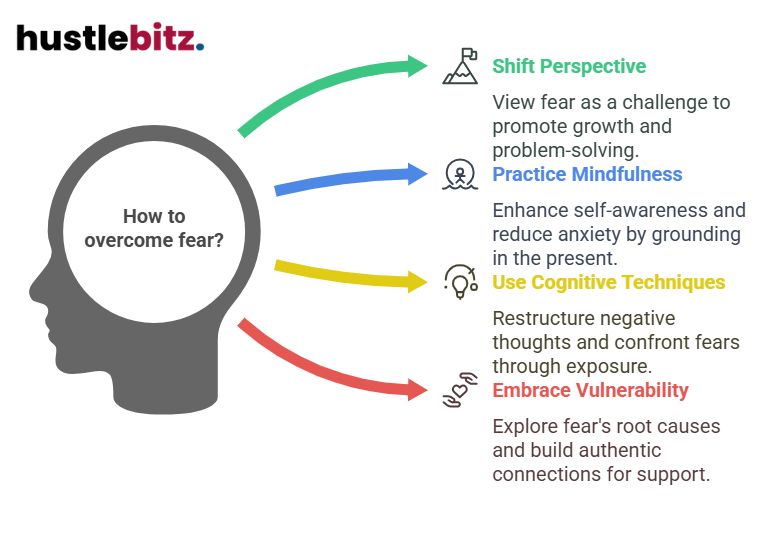Overcoming fear and anxiety is crucial for personal growth, and adopting new perspectives can significantly aid this journey. By understanding the nature of fear as a response to identifiable triggers and anxiety as generalized unease, individuals can begin to employ effective coping strategies such as mindfulness and cognitive-behavioral techniques. Shifting perspectives from negative interpretations to viewing fear as a challenge fosters resilience and personal development. Embracing vulnerability allows for emotional authenticity and deeper connections. Strengthening self-awareness through mindfulness practices and support systems further enhances one’s ability to navigate these emotions successfully, paving the way for transformative experiences ahead.
Key Takeaways
- Shift your perspective on fear by viewing it as a challenge that promotes problem-solving and personal growth.
- Practice mindfulness to enhance self-awareness and ground yourself in the present moment, reducing anxiety.
- Utilize cognitive-behavioral techniques to restructure negative thoughts and gradually confront fears through exposure therapy.
- Embrace vulnerability to explore the root causes of fears and foster authentic connections with others for emotional support.
- Build resilience by adopting coping strategies, positive affirmations, and engaging in supportive communities to navigate life’s uncertainties.

Understanding Fear and Anxiety
Recognizing the intricate relationship between fear and anxiety is essential for effectively addressing these pervasive emotional responses.
Fear typically arises from identifiable fear triggers, such as specific situations, objects, or thoughts, prompting an immediate reaction. In contrast, anxiety often manifests as a generalized sense of unease, with symptoms including excessive worry, restlessness, and physical manifestations such as increased heart rate or sweating. Understanding these distinctions is crucial for individuals seeking to navigate their emotional landscapes.
Both fear and anxiety involve complex interplay within the brain’s emotional regulation systems, leading to various coping mechanisms that individuals may adopt. Effective coping strategies can mitigate the impact of these emotional responses, enabling individuals to confront their fears and manage their anxiety. Techniques such as deep breathing, mindfulness, and cognitive-behavioral approaches can foster emotional regulation, helping individuals to reframe their perceptions of fear triggers and reduce anxiety symptoms.
Fear management becomes a critical component in this process, allowing individuals to develop resilience and a sense of control over their emotional experiences. By actively engaging in these coping mechanisms, one can cultivate a deeper understanding of their fears, ultimately transforming anxiety into a more manageable and less overwhelming presence in their lives.
As individuals learn to navigate their fears and anxieties, they pave the way for personal growth and enhanced emotional well-being, illustrating the importance of understanding these complex emotional states.
The Role of Perspective

A shift in perspective can significantly influence how individuals perceive and respond to their fears and anxieties, ultimately shaping their emotional landscape and coping strategies. By examining the way we interpret fear and its associated triggers, we can begin to understand the profound impact that perspective has on emotional reactivity. This understanding can facilitate cognitive reframing—transforming negative thought patterns into more constructive ones.
Consider the following table that illustrates how different perspectives can alter the interpretation of fear and anxiety:
| Perspective Shift | Fear Interpretation | Emotional Reactivity | Coping Strategy |
| Negative to Positive | Fear as a threat | Heightened anxiety | Avoidance |
| Threat to Opportunity | Fear as a challenge | Motivated engagement | Active problem-solving |
| Catastrophic to Realistic | Fear as an exaggerated concern | Overwhelming distress | Grounding techniques |
| Fixed to Growth Mindset | Fear as a learning opportunity | Curious exploration | Seeking support and feedback |
Through these perspective shifts, individuals can reframe their fear interpretation, leading to a more balanced emotional response. Recognizing anxiety triggers as opportunities for growth rather than obstacles fosters resilience. By adopting a growth-oriented mindset, individuals can move beyond their limitations, enhancing personal development and emotional well-being. Ultimately, the role of perspective is crucial in mitigating fear and anxiety, empowering individuals to navigate their emotional experiences with greater confidence and clarity.
Perspectives for Growth

Embracing diverse perspectives is essential for fostering personal growth and transforming fear and anxiety into valuable learning experiences. By adopting a growth mindset, individuals can view challenges as opportunities for development rather than obstacles. This shift in perspective encourages resilience and adaptability, which are crucial for navigating life’s uncertainties.
To effectively engage in this transformation, consider the following strategies:
- Positive Affirmations: Regularly practice positive affirmations to reinforce self-belief and counter negative thoughts. This practice can help individuals recognize their strengths and capabilities, thereby reducing anxiety.
- Emotional Intelligence: Cultivating emotional intelligence allows individuals to better understand their own emotions and those of others. This awareness can lead to more effective coping strategies and improved interpersonal relationships, fostering a sense of community and support.
- Supportive Communities: Surrounding oneself with supportive communities can significantly enhance personal growth. Engaging with others who share similar challenges provides encouragement and shared experiences, facilitating fear transformation and promoting a sense of belonging.
Mindfulness and Self-Awareness

Mindfulness and self-awareness serve as powerful tools for individuals seeking to navigate and mitigate the impacts of fear and anxiety in their lives. By engaging in mindfulness practices, individuals can cultivate an acute awareness of their thoughts, emotions, and physical sensations, fostering a deeper understanding of their internal experiences. This heightened self-awareness is essential for effective emotional regulation, as it allows individuals to recognize when anxiety arises and respond to it thoughtfully rather than reactively.
Self-awareness techniques, such as journaling or guided meditation, encourage individuals to explore their emotional landscapes and identify patterns related to their fears. This exploration not only promotes insight but also enhances one’s ability to remain anchored in the present moment. Mindfulness practices, such as focused breathing or body scans, assist in grounding individuals, enabling them to observe their thoughts without judgment and reducing the power of anxiety over their lives.
Furthermore, the cultivation of compassion—both for oneself and others—plays a crucial role in this process. Compassion cultivation encourages individuals to treat themselves with kindness during moments of fear or anxiety, fostering resilience and self-acceptance.
Cognitive Behavioral Techniques

Cognitive Behavioral Techniques (CBT) offer effective strategies for individuals to identify and challenge negative thought patterns that contribute to fear and anxiety. By focusing on the interplay between thoughts, feelings, and behaviors, CBT empowers individuals to take an active role in their anxiety management.
The following techniques are key components of CBT:
- Thought Restructuring: This involves recognizing and reframing cognitive distortions, such as catastrophizing or black-and-white thinking. By challenging these irrational thoughts, individuals can develop a more balanced perspective.
- Exposure Therapy: This technique gradually exposes individuals to feared situations or stimuli in a controlled manner. Through repeated exposure, anxiety tends to diminish over time, allowing individuals to confront and overcome their fears.
- Behavioral Activation: This approach encourages individuals to engage in enjoyable or meaningful activities. By increasing positive interactions with their environment, individuals can counteract feelings of anxiety and depression, promoting emotional well-being.
CBT not only focuses on altering negative thought patterns but also emphasizes the importance of taking actionable steps to improve mental health. By employing these techniques, individuals can work towards overcoming anxiety and fear, fostering personal growth.
As they learn to manage their thoughts and behaviors, they develop resilience and a greater sense of control over their lives, ultimately leading to improved quality of life.
Embracing Vulnerability
Vulnerability serves as a crucial pathway for personal growth, allowing individuals to confront their fears and anxieties with authenticity and courage.
Embracing vulnerability involves a deep commitment to vulnerability acceptance, which encourages individuals to acknowledge their emotions without judgment. This emotional openness fosters an environment where one can explore the underlying causes of their fears, paving the way for transformative experiences.
By practicing self-compassion, individuals learn to treat themselves with kindness rather than criticism when facing uncomfortable emotions. This shift not only alleviates anxiety but also enhances emotional resilience.
As individuals become more accepting of their vulnerabilities, they inadvertently engage in trust building with others. Sharing fears and uncertainties creates opportunities for profound connections, enabling authentic connections to flourish.
These connections are essential for emotional support and validation, reinforcing the belief that one is not alone in their struggles. Individuals who embrace their vulnerabilities often find that they can relate to others on a deeper level, leading to richer interpersonal relationships.
Moreover, engaging in self-compassion practices cultivates a sense of safety, allowing individuals to express themselves genuinely. This expression fosters community and belonging, further mitigating feelings of isolation that often accompany anxiety.
In essence, embracing vulnerability is not merely an act of bravery; it is a fundamental step in overcoming fear and anxiety, leading to a more fulfilling and connected life.
Building Resilience

Resilience is the cornerstone of overcoming fear and anxiety, enabling individuals to bounce back from challenges while maintaining a sense of hope and purpose. Building resilience involves developing emotional strength and fostering an adaptive mindset. This process can significantly enhance one’s ability to navigate life’s uncertainties and stresses.
To effectively cultivate resilience, consider the following strategies:
- Engage in Resilience Training: Structured programs can teach individuals various coping strategies tailored to their specific circumstances. These trainings often focus on enhancing emotional intelligence, which is instrumental in recognizing and managing emotions.
- Develop Support Systems: Establishing a strong network of friends, family, or professional mentors can provide the emotional backing needed during tough times. Support systems enable individuals to share their experiences, gain insights, and feel less isolated in their struggles.
- Practice Mindfulness and Self-Reflection: Fostering an adaptive mindset requires regular self-assessment and mindfulness practices. Engaging in activities such as journaling or meditation can help individuals recognize their thoughts and feelings, promoting a greater understanding of their emotional landscape.
Incorporating these strategies can lead to improved coping mechanisms, empowering individuals to face challenges with greater confidence. As one builds resilience, the ability to confront fear and anxiety becomes less daunting, ultimately paving the way for personal growth and transformation.
Final Thoughts
Overcoming fear and anxiety is a transformative process that paves the way for personal growth and emotional resilience. By embracing techniques such as mindfulness, cognitive-behavioral strategies, and vulnerability, individuals can shift their perspectives, turning fear into an opportunity for development. Building strong support systems and practicing self-compassion are key to navigating these emotions with authenticity and courage. Ultimately, confronting fear and anxiety allows for deeper connections, enhanced self-awareness, and a more fulfilling, resilient life. The journey may be challenging, but it leads to profound personal growth and emotional well-being.




